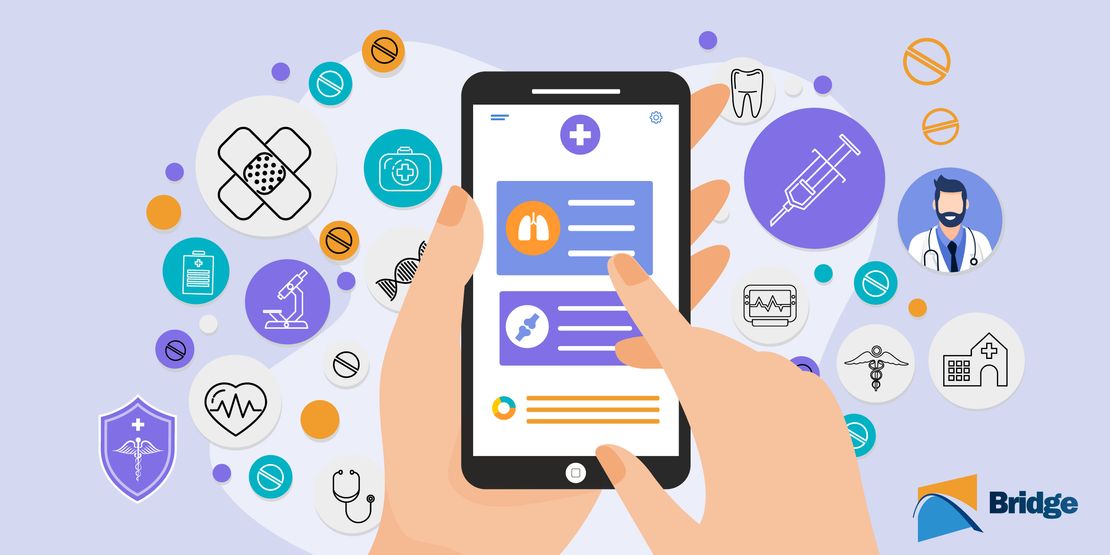The Use of mHealth Solutions to Improve Patient Education
- The Bridge Team
- June 14, 2022

Therapeutic patient education[¹]aims to enable patients to manage their condition and prevent avoidable complications while maintaining or improving their quality of life. It aims to produce a therapeutic effect that will complement all other interventions, such as pharmacological or physical therapy interventions.Patient education is an essential part of the treatment of acute and chronic conditions. It’s known to improve certain vital factors, including patients’ engagement in their own care, medication and treatment adherence, patient satisfaction levels, and treatment outcomes.
Medical professionals should improve patient education at various points during a patient’s journey. Preoperative needs-based education can be implemented to reduce anxiety, increase satisfaction, and decrease the time patients spend in day-surgery clinics. Post-operative or post-visit education can instruct patients on their treatment plan, increasing adherence and reducing readmissions. Patient education also helps reduce the cost of long-term care to patients and society.
Outdated Patient Education
Currently, most healthcare providers talk to patients about their disease during a short visit rather than train them in their condition’s daily management. This method of “education” does nothing to improve patient education, help the patient manage their condition, or follow a treatment plan. It may also lead to complications in the future, as verbal education[²] within a consultation is quickly forgotten or reinterpreted. Patient education counters this information loss and reinterpretation by reducing the need to remember spoken instructions.
Printed educational materials have been found to be ineffective[³] with little to no difference to patient health. The impact on patients with low health literacy levels is even more extreme, with this group 4.5-times[⁴] more likely to experience a post-surgical infection.
Patients have apparent difficulties in processing large amounts of new medical information. It is suggested that information should be “dripped” or slowly provided to the patient in easily consumable pieces, using mobile health solutions accessed via a smartphone or tablet.
A Patient Portal Solution for Patient Education
Personalized patient education should be tailored to how a patient learns, the patient’s capabilities, and how they respond to information. 85%[⁵] of the American population uses a smartphone; this is why many healthcare organizations are looking to leverage a patient portal solution and other mobile health solutions to actively educate patients by providing them with timely information on their phones.
Results of a systematic review that aimed to measure the effects of using mhealth solutions and smartphone apps to educate patients with timely education[⁶]:
| Improved Measure | Period | Frequency |
|---|---|---|
| Satisfaction with the information | Longer than one month | One message per week |
| Satisfaction with the care provided | Shorter than one month | One message per week |
| Adherence to treatment instructions | Longer than one month | One message per week |
| Medication adherence | Longer than one month | One message per week |
| Patient’s quality of life | Shorter than one month | More than one message per week |
| Physical function and pain | Shorter than one month | More than one message per week |
The effectiveness of automated patient education has been shown to increase by 9% when at least one push notification is sent per week, while the effectiveness increases by 13% when the duration of the education is shorter than one month. Providing patient education via a patient portal solution has the highest impact on overall knowledge 100%[⁶], satisfaction with information provided 93%, medication adherence 84%, adherence to treatment instructions 75%, and clinical outcomes 74%. These positive effects of patient education are most pronounced when information is provided over a short duration (i.e., less than a month) and with a high frequency of messages to patients (i.e., once per week or more).
Healthcare organizations seeking to improve patient outcomes and engagement should consider leveraging mHealth solutions like patient portals. In particular, they should seek one that provides patients access to a patient education library and sends timely push notifications.
- Correia, J. C., Waqas, A., Aujoulat, I., Davies, M. J., Assal, J.-P., Golay, A., & Pataky, Z. (2022). Evolution of therapeutic patient education: A systematic scoping review and scientometric analysis. International Journal of Environmental Research and Public Health. Available at: https://www.preprints.org/manuscript/202203.0131/v1
- ResearchGate. (n.d.). Strategies for improving the quality of verbal patient and family education: A review of the literature and creation of the EDUCATE model. [online] ResearchGate. Available at: https://www.researchgate.net/publication/271900748_Strategies_for_improving_the_quality_of_verbal_patient_and_family_education_A_review_of_the_literature_and_creation_of_the_EDUCATE_model
- Giguère , A., Zomahoun , H. T., Carmichael , P. H., Uwizeye , C. B., Légaré , F., Grimshaw , J. M., Gagnon , M. P., Auguste , D. U., & Massougbodji , J. (2020). Printed educational materials for healthcare professional practice and Patient Health. [Online] Cochrane. Available at: https://www.cochrane.org/CD004398/EPOC_printed-educational-materials-healthcare-professional-practice-and-patient-health
- American College of Surgeons. (n.d.). Low health literacy may be a risk factor for postoperative infection. [online] American College of Surgeons. Available at: https://www.facs.org/media/press-releases/2020/low-health-literacy-082420
- Pew Research Center. (2021). Mobile Fact Sheet. [online] Statista. Available at: https://www.pewresearch.org/internet/fact-sheet/mobile/
- Timmers, T., Janssen, L., Kool, R.B. and Kremer, J.A. (2020). Educating Patients by Providing Timely Information Using Smartphone and Tablet Apps: Systematic Review. [online] Journal of Medical Internet Research. Available at: https://www.jmir.org/2020/4/e17342/